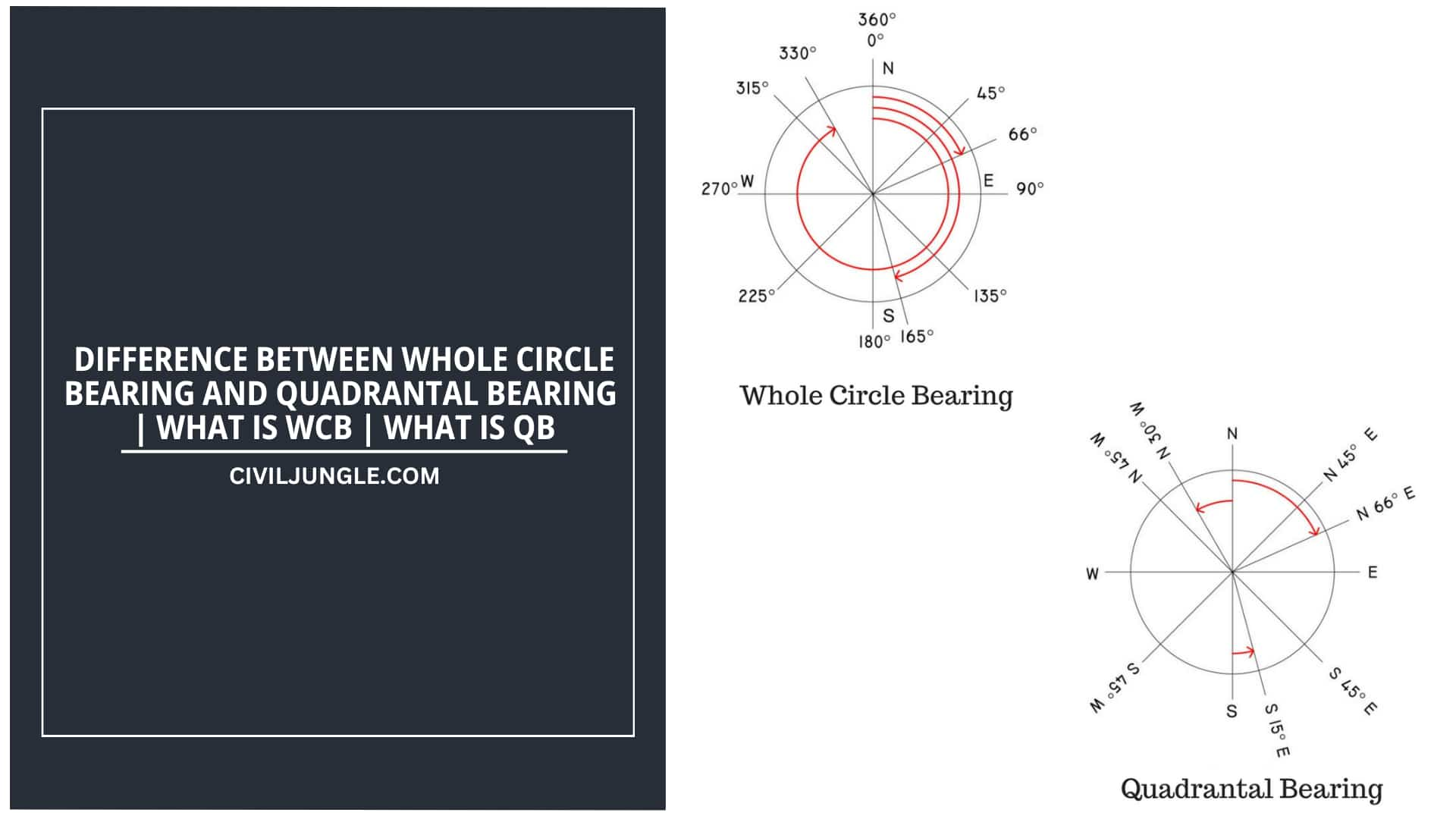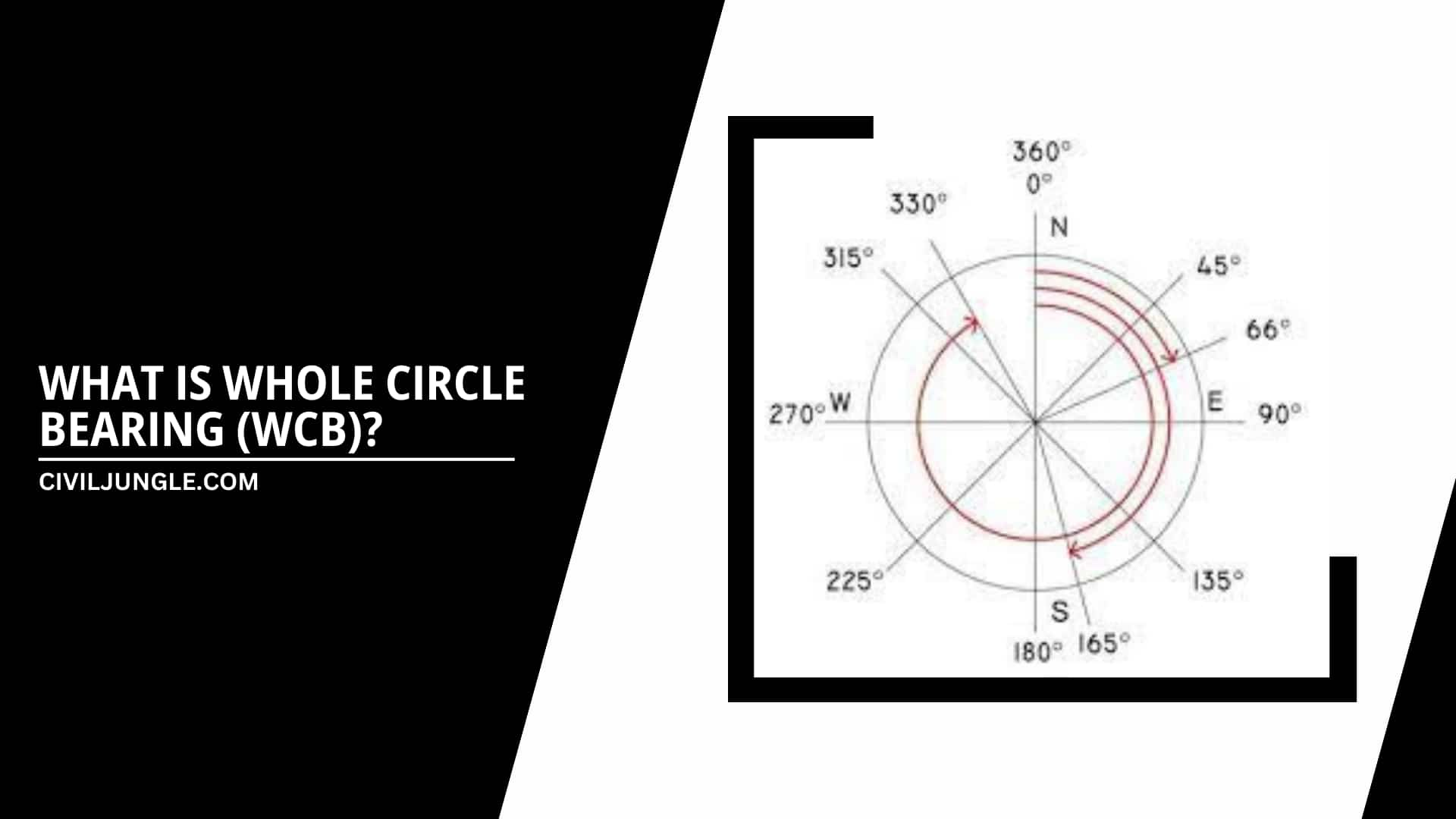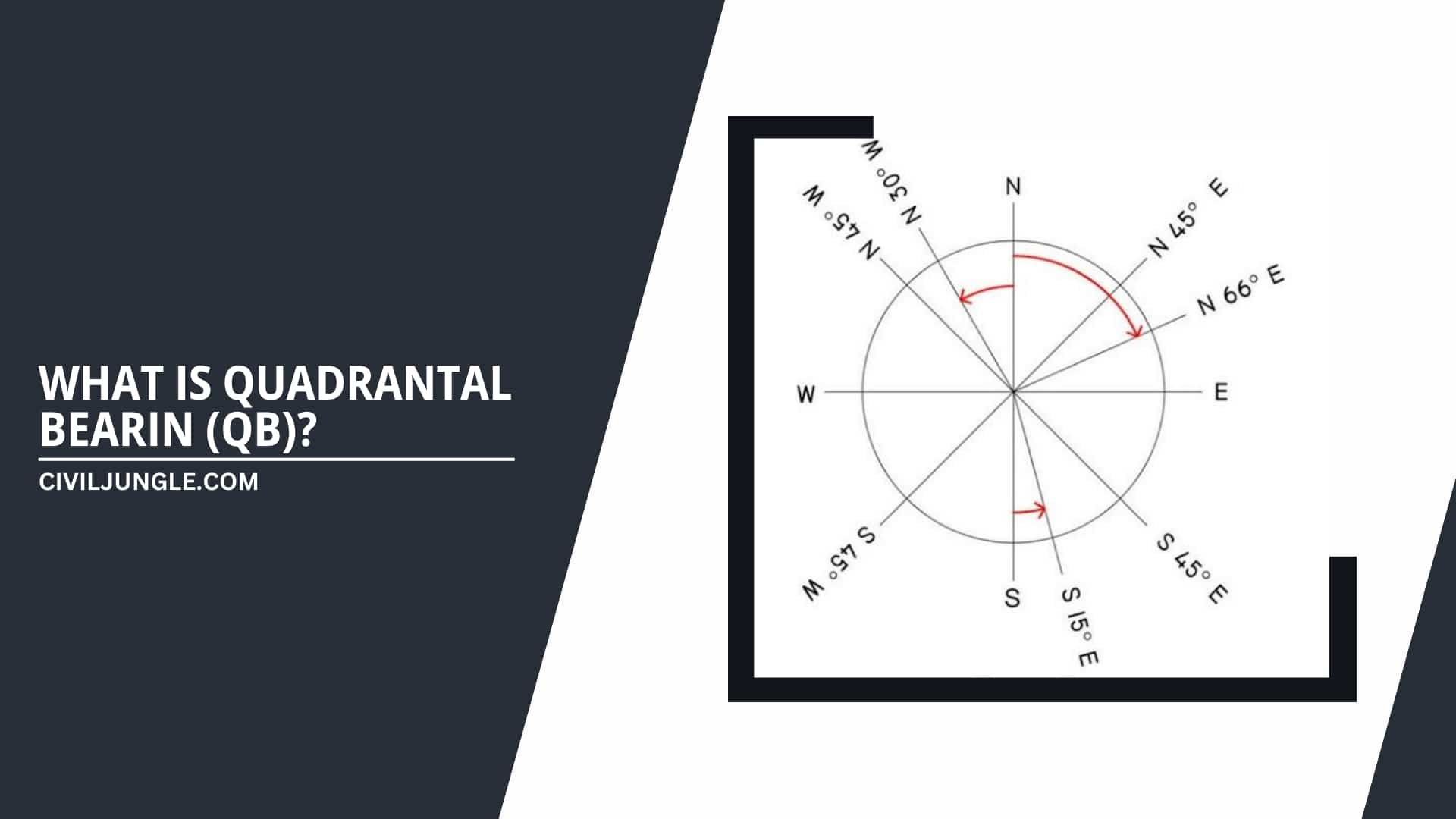Introduction of WCB Vs. QB
Important Point
When discussing wcb in surveying, it’s essential to understand that Whole circle bearing(WCB) and Quadrantal bearing(QB) are the two types of bearing used in the field of surveying for the purpose of measurement of the bearings.
In this article, you will get to know about the whole circle bearing and Quadrantal bearing and their differences.
What Is Whole Circle Bearing (WCB)
- For those wondering ‘define whole circle bearing‘, the whole circle bearing (WCB) is defined as the bearing of the line at any point which is measured with respect to the Meridian.
- The Whole Circle bearings values range from 0° to 360°.
- The Whole circle bearing is generally used in the Prismatic compass.
- The whole circle bearing is used to measure the angle in the clockwise direction from the magnetic North.
- The Prismatic compass is graduated by Whole circle bearing.
Also, read: What Is Passometer & Pedometer | Advantage of Passometer & Pedometer
Example of Whole Circle Bearing (WCB)
- If the survey line falls between the first quadrant then the Whole Circle Bearing lies between the 0° to 90°.
- If it lies between the second quadrant then the Whole Circle Bearing of that survey line lies between 90° to 180°. If it lies in the third quadrant then the Whole circle bearing will be between the 180° to 270°.
- And in the fourth quadrant, the Whole Circle Bearing values range between 270° to 360°.
- The Whole circle bearing of any line can exceed up to 90°. When converting whole circle bearing to reduced bearing or wcb to qb, it can be reduced to the corresponding angle which is less than 90°.
- This type of angle is also known as a Reduced bearing.
- The examples of whole circle bearing are as follows.
- 30°,45°,80°,120°,230°, and 320°, etc
Also, read: Prismatic Compass Survey Vs Surveyor Compass. | Least Count of Prismatic Compass & Surveyor Compass
What Is Quadrantal Bearin (QB)
The Quadrantal bearing, often referred to as reduced bearing in surveying, is also known as a Reduced bearing. Quadrantal bearings are generally measured from the North or South direction towards the East or West direction.
The quadrantal bearing or reduced bearing can be measured either in a clockwise or anticlockwise direction.
The quadrantal bearing varies from 0° to 90°.
In the quadrantal bearing or reduced bearing system, the bearings are taken either from the magnetic North or the magnetic south direction. It will depend on which one is nearer to that line.
In the Quadrantal bearing system, magnetic North and magnetic South lines are considered as reference line.
Example of Quadrantal Bearing
In the quadrantal bearing system, you can take both clockwise as well as anticlockwise angle from the reference line.
It is necessary to state the particular quadrant in which that line lies. The letters N(north), S(south), E(east), and W( west) are used to represent the quadrant.
Reduced bearing is observed by the surveyor’s compass.
The quadrants are represented are as follows.
- 1st quadrant = N – E
- 2nd quadrant = S – E
- 3rd quadrant = S – W
- 4th quadrant = N – W
The example of the quadrantal bearing are as follows
- N35°E,S49°E,N65°W,S25°W etc.
Difference Between Whole Circle Bearing and Quadrantal Bearing
Understanding the difference between whole circle bearing and reduced bearing is crucial. The whole circle bearing and quadrantal bearing or reduced bearing are the two bearings that are usually used in the compass surveying.
In order to choose between the whole circle bearing and quadrantal bearing, you must know the difference between them.
he difference between the whole circle bearing and quadrantal bearing are as follows.
| Sr.No. | Whole Circle Bearing | Quadrantal Bearing |
| 1 | The horizontal angle which is made by the survey line, with the magnetic north in a clockwise direction is known as the Whole circle bearing. | The horizontal angle which is made by a survey line with the magnetic North or South whichever is near the line in the eastward or westward direction is known as quadrantal wearing or reduced bearing. |
| 2 | In the whole circle bearing, the magnetic North line is considered as the reference line. | In the quadrantal Bearing, both magnetic North as well as South lines are considered as a reference line. |
| 3 | In the whole circle bearing only clockwise angle is taken from the reference survey line | In the quadrantal bearing both clockwise, as well as the anticlockwise angle from the reference line, is taken |
| 4 | The value of the whole circle bearing ranges from 0° to 360° | The value of the quadrantal wearing for reduced bearing ranges from 0° to 90° |
| 5 | The example of a whole circle bearing are 30°,45°,80°,120°,230°, and 320°, etc | Example of quadrantal bearing or reduced bearing are N35°E, S49°E, N65°W, S25°W, etc. |
Observation of the Bearings
- When considering the whole circle bearing system in surveying, consider the bearing of the line is AB to be observed.
- Set up the instrument and at station A and then carry out the temporary adjustments.
- Fix one of the ranging rods at the station B.
- Turn the compass box until the ranging rod present at station B is not bisected by the horsehair when seen through the vertical slit above the prism.
- When the needle comes to rest, bisect it by the ranging rod at station B accurately and write down the reading.
- Hence you will get a bearing of the line AB.
What Is a Whole Circle Bearing (Wcb)?
a Whole Circle Bearing (Wcb) Refers to the Bearing of a Line at Any Point, Measured with Respect to the Meridian.
What Is the Range of Values for Whole Circle Bearings?
the Values of Whole Circle Bearings Range from 0° to 360°.
How Is a Whole Circle Bearing Used in Surveying?
the Whole Circle Bearing Is Generally Used in the Prismatic Compass to Measure Angles in the Clockwise Direction from the Magnetic North.
What Is a Quadrantal Bearing (Qb)?
a Quadrantal Bearing (Qb) Is Also Known as a Reduced Bearing, and It Is Measured from the North or South Direction Towards the East or West Direction.
How Is a Quadrantal Bearing Measured?
a Quadrantal Bearing Can Be Measured Either in a Clockwise or Anticlockwise Direction.
What Is the Range of Values for Quadrantal Bearings?
Quadrantal Bearings Vary from 0° to 90°.
What Reference Lines Are Used in the Quadrantal Bearing System?
the Quadrantal Bearing System Uses Either the Magnetic North or South Lines as Reference Lines, Depending on Which One Is Nearer to the Line Being Measured.
What Is the Main Difference Between Whole Circle Bearings and Quadrantal Bearings?
the Main Difference Lies in the Direction of Measurement: Whole Circle Bearings Are Measured Clockwise from the Magnetic North, While Quadrantal Bearings Are Measured Towards the East or West from the North or South, Depending on Proximity.
What Are the Reference Lines for Each Type of Bearing?
in Whole Circle Bearings, the Magnetic North Line Is the Reference, While in Quadrantal Bearings, Both Magnetic North and South Lines Are Reference Lines.
Can You Summarize the Value Ranges for Each Type of Bearing?
Whole Circle Bearings Range from 0° to 360°, Whereas Quadrantal Bearings Range from 0° to 90°.
Are Both Clockwise and Anticlockwise Angles Used in These Bearings?
Yes, in Quadrantal Bearings, Both Clockwise and Anticlockwise Angles Are Used, While in Whole Circle Bearings, Only Clockwise Angles Are Considered.
Like this post? Share it with your friends!
Suggested Read –
- Introduction of Gantry Girder | Load on Gantry Gutter | Types of Load on Gantry Gutter
- What Is Dry Pack Mortar | Advantages of Dry Pack Mortar | Disadvantages of Dry Pack Mortar
- What Is Unit Weight | What Is Density | What Is Unit Weight Material | Unit Weight Building Materials
- What Is Pier Foundation | Types of Drilled Piers | Advantages and Disadvantages of Drilled Pier Foundations
- What Is Diversion of Headworks (Rivers) | Types of Diversion Headworks | Component Parts of Diversion Headworks (Rivers)
Originally posted 2021-10-25 02:26:38.




Leave a Reply